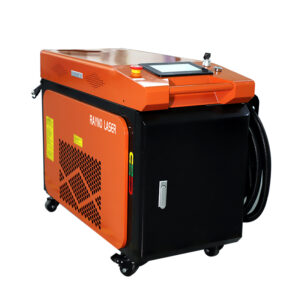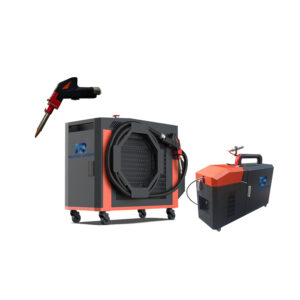In a previous article, we discussed the causes and solutions for when the wire feeder roller of a handheld laser welding machine fails to operate. Today, we will focus on another common issue: wire feeding not running smoothly. This problem can disrupt welding operations and affect the quality of the weld. In this guide, we will outline the most common causes of this issue and provide practical solutions to help you get back to seamless welding.
Understanding the Problem
When using a handheld laser welding machine, smooth wire feeding is essential to ensure consistent and high-quality welds. However, you might encounter instances where the wire feeding mechanism is inconsistent, causing interruptions. This issue typically stems from mechanical factors such as the condition of the wire, the alignment of the feeding tube, or mismatched components.
Common Causes of laser welder Wire Feeding Issues
- Excessive Bending of the Wire Feeding Tube
- The wire feeding tube is designed to guide the welding wire from the feeder to the welding tip. If the tube is excessively bent, it creates resistance that impedes smooth wire movement.
- Deformed or Bent Welding Wire
- Welding wires that are bent or deformed before entering the feeding tube can cause blockages or irregular feeding.


- Mismatched Wire and Feeding Wheels Model
- Different types of wires, such as stainless steel, carbon steel, or aluminum, require specific feeding rollers.Welding wires are not only available in different materials and weights, but also in different diameters to suit different sizes of welding gaps. Commonly used welding wires are 0.8mm, 1.0mm, 1.2mm, 1.6mm and 2mm. If you want to use 0.8mm welding wire, you need to use a 0.8mm wire feed wheel. Using the wrong roller can cause the wire to slip or get stuck.

- Loose Set Screws on the Wire Feeding Tube
- The set screws that secure the feeding tube may become loose over time, causing the spring tube inside to retract. This misalignment can obstruct smooth wire feeding.
Step-by-Step Solutions of wire feeding rolls not working smoothly
1. Straighten the Wire Feeding Tube
- Why: Bends in the feeding tube increase friction and block the wire’s movement.
- Solution:
- Before welding, ensure the wire feeding tube is straight and free of any kinks or folds.
- If the feeding tube has a sharp bend or is damaged, cut off the bent section or replace the tube entirely.
2. Ensure the Welding Wire is Straight
- Why: Bent or deformed wires can get stuck inside the feeding tube, leading to irregular feeding.
- Solution:
- Inspect the welding wire before feeding it into the tube.
- Cut off any bent sections and make sure the wire entering the tube is straight.
- Store welding wires properly to prevent bending or damage during handling.
3. Use the Correct Feeding Roller and Tube
- Why: Different materials and wire diameters require specific rollers and feeding tubes for smooth operation.
- Solution:
- Match the size of the feeding roller to the diameter of the welding wire. For example:
- Use a V-shaped roller and standard feeding tube for stainless steel or carbon steel wires.
- Use a U-shaped roller and a graphene feeding tube for aluminum wires, as these materials require smoother feeding to prevent damage.
- Consult the machine manual to ensure compatibility between your wire, roller, and feeding tube.
- Match the size of the feeding roller to the diameter of the welding wire. For example:
4. Tighten the Set Screws on the Wire Feeding Tube
- Why: Loose set screws can cause the spring tube to retract, disrupting the alignment of the feeding system.
- Solution:
- Check the set screws securing the feeding tube. These screws should press firmly against the spring tube.
- If the screws are loose, tighten them to ensure the spring tube stays in place.
- Reinstall the feeding tube if necessary to correct its position.
Best Practices for Smooth Wire Feeding
- Regular Maintenance:
- Clean the wire feeder and feeding tube to remove any debris or residue that might obstruct wire movement.
- Periodically check the feeding mechanism for signs of wear and tear, especially the rollers and tubes.
- Store Materials Properly:
- Prevent damage to welding wires by storing them in a dry, clean environment. Avoid stacking or bending wires during storage.
- Inspect Before Use:
- Always check the feeding system and wires before starting any welding job. This ensures any potential issues are addressed beforehand, reducing downtime.
- Avoid Signal Interference:
- If you’re using additional welding equipment like TIG machines nearby, ensure they are not interfering with the wire feeder’s electrical signals.
Rayno Laser Hot Selling Laser Welding Machine
Smooth wire feeding is a critical factor in achieving consistent and high-quality welds with a handheld laser welding machine. By addressing issues such as bent tubes, deformed wires, mismatched components, and loose screws, you can ensure reliable operation and minimize disruptions.
Remember, regular maintenance and proper handling of the wire feeding system are key to preventing these issues in the first place. If you encounter persistent problems, consult your machine’s manual or reach out to a professional technician for assistance.
By taking these steps, you’ll be well-equipped to handle wire feeding challenges and achieve optimal welding performance.





